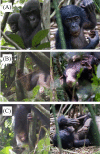Two wild female bonobos adopted infants from a different social group at Wamba
- PMID: 33737517
- PMCID: PMC7973529
- DOI: 10.1038/s41598-021-83667-2
Two wild female bonobos adopted infants from a different social group at Wamba
Abstract
Adoption, the act of taking another individual's offspring and treating it as one's own, is rare but widely observed in various mammal species and may increase the survival of adoptees. Adoption may also benefit adoptive mothers, for example they might care for close kin to gain indirect fitness or to learn caregiving behaviours. Here, we report two cases of a wild bonobo adopting an infant from a different social group, the first report of cross-group adoption in great apes. In one case, the adoptive mother was already a mother of two dependent offspring. In the other case, the adoptive mother was an old parous female whose own offspring had already emigrated into a different social group. The adoptive mothers provided various maternal care to the adoptees, such as carrying, grooming, nursing, and sharing food. No aggression was observed by group members towards the out-group adoptees. In both cases, adoptees had no maternal kin-relationship with their adoptive mothers. Both adoptive mothers already had experience of rearing their own offspring. Instead, these cases of adoption may have been driven by other evolutionary adaptive traits of bonobos, such as their strong attraction to infants and high tolerance towards immatures and out-group individuals.
Conflict of interest statement
The authors declare no competing interests.
Figures





References
-
- Gubernick DJ, Klopfer PH. Parental Care in Mammals. New York: Plenum Press; 1981.
-
- Riedman ML. The evolution of alloparental care and adoption in mammals and birds. Q. Rev. Biol. 1982;57:405–435. doi: 10.1086/412936. - DOI
Publication types
LinkOut - more resources
Full Text Sources
Other Literature Sources

